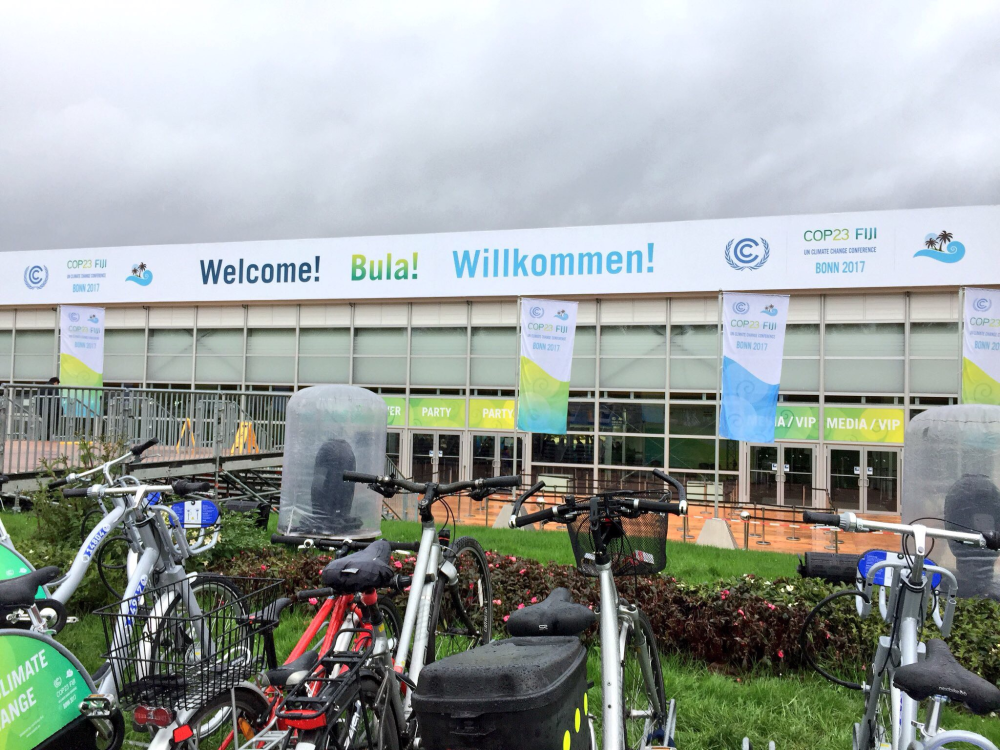The latest round of international climate negotiations wrapped last week in Bonn, Germany. The 23rd session of the Conference of the Parties (COP) was presided by the Government of Fiji — remarkably, the first small island state to ever host a UN climate summit.
Small island states like Fiji, itself still recovering from the damage wrought by Cyclone Winston in 2016, are at the frontlines of the climate crisis. They bring a crucial sense of urgency and ambition to these international negotiations: the difference between 1.5 or 2 degrees of warming (the ambition outlined in the Paris Agreement), and the related impact on sea-level rise, will define the economic, cultural, and environmental prospects of Island people for generations to come.
Despite Fiji’s COP23 presidency, the negotiations weren’t held on a beach: they were held in chilly Germany, at the seat of the United Nations Framework Convention on Climate Change’s secretariat. This might seem confusing, but this venue was chosen for practical reasons: Fiji had more than enough political might to preside over the COP, but physically hosting +25,000 international delegate would have placed a significant burden on its financial and infrastructure resources.
What was accomplished?
After two intense weeks, negotiators and observers have come away from Bonn with a sense of steady progress along several important dimensions of the Paris Agreement. One of the main tasks facing Parties is to reach consensus on the Agreement’s implementation guidelines, also known as the “Paris rulebook”. This set of rules, guidelines, and procedures will operationalize the Paris Agreement and clarify countries’ requirements once the Agreement is in force in 2020. In other words, if the Paris Agreement is the hardware, the rulebook is the software.
The rulebook will cover several interrelated elements of the Agreement, including: a transparency framework for reporting and review of countries’ actions; accounting rules to enhance understanding of countries’ targets and plans, and to facilitate the creation of international market mechanisms; and the “global stock-take” mechanism to assess every five years how far off countries’ pledges are from meeting the temperature limits outlined in the Paris Agreement.
The rulebook is due to be finalized by next year’s climate talks in Katowice, Poland. But progress on various technical matters at COP23 was essential to meeting that 2018 deadline. Other important progress, like formally linking the Adaptation Fund to the Paris Agreement, and reaching consensus on how to address issues related to agriculture and climate change, was also made in Bonn.
Translating the Paris Agreement into action in the real economy
Importantly, new progress was made to translate the ambition of the Paris Agreement into concrete policy changes in respective national economies. For example, Canada, together with the UK, launched the Global Alliance on Powering Past Coal, spanning 20 national and seven sub-national governments. This Global Alliance is premised on simple, but stark, science: in order for the world to achieve the Paris Agreement temperature limits, all OECD countries must phase-out coal-fired power by 2030 — and, in the wider world, coal use in the power sector must end by mid-century. To this end, Alliance members agreed to phase out traditional coal-fired power, and place a moratorium on new coal plants without fully operational carbon capture and storage facilities. The Alliance also welcomed private sector members who are committed to powering their operations without coal. So far, only Unilever has agreed to sign on — but the We Mean Business Coalition has put out a call for forward-looking businesses to commit to the Alliance. We think this structure holds a lot of promise, and exemplifies the type of collaborative effort required to unlock real progress towards the Paris Agreement.
COP23 also saw progress on another important source of carbon pollution: hydrofluorocarbons (HFCs), man-made chemical compounds used in air conditioners, refrigerants and other cooling devices that are also, unfortunately, powerful greenhouse gases. After some heavy lifting from Canada and Rwanda, the Kigali Amendment crossed the 20-country threshold for entry into force on January 1st, 2019. The Kigali Amendment seeks to accelerate the phase-down of the production and consumption of HFCs, with an overarching global target of reducing global HFC consumption by 80 to 85 per cent by 2047. In practice, the Kigali Amendment will drive greater energy efficiency in heating and cooling around the world — and, with any luck, the private sector will step up to provide equipment and other technical solutions to accelerate the phase-out of HFCs.
These are two examples of exactly the kind of progress the world needs: while it’s obviously necessary to continue on-going technical negotiations in wonky international forums, it’s essential that the Paris Agreement have impact outside of the COP process. Doing so requires better connecting the Paris Agreement’s ambition to domestic policy processes and to financial investments unfolding in real-time around the world. Efforts like the off-coal alliance and the HFC phase-down helpfully translate the spirit of the Paris Agreement into meaningful signals to business, governments and citizens — precisely what we need to make real progress building low-carbon and resilient national economies.
Ratcheting up global ambition via the Talanoa Dialogue
COP23 also laid the groundwork for increased collective action through 2018.
In the adoption of the Paris Agreement, Parties agreed to “convene a facilitative dialogue among Parties in 2018 to take stock of the collective efforts of Parties in relation to progress towards the long-term goal”.
Unlike previous global climate accords, the Paris Agreement establishes a process through which, every five years, countries take stock of collective action and chart a course to increased ambition. The Talanoa Dialogue, which took full shape at COP23, will be the first step in this journey toward increased global action.
The presidencies of COP22 and COP23 (held by the Kingdom of Morocco and Government of Fiji, respectively) tabled an informal note outlining their proposed structure for the Talanoa Dialogue. They propose the dialogue be centered around three core questions: 1. Where are we?; 2. Where do we want to go?; and 3. How do we get there? Further, that the dialogue consist of both a preparatory phase and a political phase, set to conclude at Poland’s COP24 next year.
The document notes it will be important to “send clear forward looking signals to ensure that the outcome of the dialogue is greater confidence, courage and enhanced ambition.”
We couldn’t agree more with this approach, and expect Canada to play its part by role modelling increased policy ambition at home.
2018 will be Canada’s year to shine
The global community will be laser focused on mounting ambition — and Canada, with its constructive presence on the international stage, must do everything it can to ensure a successful global outcome next year. In our view, this should include signalling our commitment to enhance our nationally determined contribution (NDC, presently to reduce emissions by 30 per cent below 2005 levels by 2030) and to increase our climate finance pledge (presently $2.65 billion by 2020) before the Paris Agreement is fully in force in 2020.
When the Paris COP concluded in December 2015, we said its success would be measured by policy progress here at home. Nearly two years out, it’s clear Canada has made important, and irreversible progress: Canadian businesses now expect to pay a $50 price on their pollution by 2022, climate-related financial risk disclosure is picking up momentum across corporate boardrooms, and national policy architecture to accelerate decarbonization of Canada’s economy is beginning to take shape.
But, as it stands, Canada’s pledge — both at home and abroad — isn’t enough. 2018 is a year of mounting ambition, and we expect Canada to put its political muscle behind a successful Talanoa Dialogue process. And, as we step into our own G7 presidency, the prime minister and his cabinet would do well to adopt the Pacific tradition of Talanoa as they work to advance cooperation and collective action on climate and energy issues with peer economies. While it won’t be easy, the G7 remains an important forum for global norm-setting, and we strongly encourage Canada to ensure its presidency furthers the global agenda on mounting ambition—even at the cost of full consensus. 2018 will be Canada’s year to step up on climate action, and in doing so, to solidify its position as a good global steward of the Paris Agreement.







